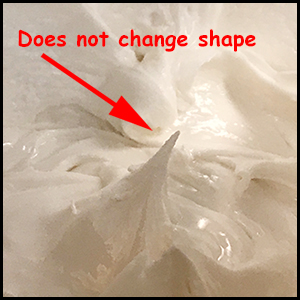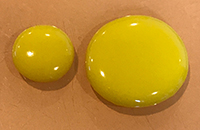Comparing Royal Icing Recipes, With and Without Corn Syrup (updated 4/25/19)

The basic Royal Icing recipe, which I call “stiff,” is made from pasteurized egg whites and powdered sugar. A variation, which I call “firm,” is made from the same two ingredients, but with slightly more moisture. That moisture can be from water, light corn syrup, or a combination of both.
I do not recommend any recipe that uses meringue powder, even though what I’m sharing here also applies to meringue powder-based recipes. If you do use that product, adding light corn syrup to that mix will improve your outcome, which might otherwise be dull, prone to pitting, sunken, or dry “in waves” or dents.
Initial Appearances
Royal Icing made with pasteurized egg whites results in an almost fool-proof product, but the addition of light corn syrup to it produces icings that dry with shiny surfaces. Depending on the humidity and other factors, however, your initial mixture will be either stiff or firm.
The following photos show a firm mixture that flattens over time to a flat surface.
You can do almost everything with firm-but-not-stiff icing except make 3D structures, like flowers and decorative borders, which must exist without changing shape. To test whether your initial batch is very stiff or just firm, pull a spoon or mixing blade up through the mixture. Stiff peaks do not change shape, while firm peaks do. The speed in which firm peaks flatten depends upon the moisture in the mix.
Observing Consistencies
The measured ingredients of pasteurized egg whites and 10X (highly refined) powdered sugar is not exacting. Depending on the consistencies you need, adjustments are made as you work with Royal Icing by adding (or subtracting) powdered sugar or moisture (water or light corn syrup). Your success depends on your understanding of consistency.
Flood consistency: This mixture will eventually flatten, making a perfect cookie covering, like you see in the photo below. The speed in which it flattens depends on how wet it is. A good flood consistency will not be so wet that it runs off the sides of a cookie or overrides a border (barrier) you made to contain it. To change a firm consistency into a flood consistency, add light corn syrup to the mix and/or very lightly spritz it with water from a food-grade spray bottle.
Note that dots (or “pearls”), like you see in the first image on this page, are made using a consistency that that requires some testing before you commit. With the proper consistency, the tops of the dots settle into a nice rounded shape and their bodies do not spread. If the tops of your dots stand like peaks, the consistency is too dry. If they sink and run, too wet. If you see holes in them, you are probably using meringue powder without light corn syrup.
Firm, piping consistency: This mixture flows out of a piping tip when light pressure is applied to the bag, but does not pour out on its own. If it does, your mixture is too moist. If, however, a piped line appears both thick and thin and its lines ruffle or break as you pipe them, the consistency is too thick for the current task or the piping tip. When you see your icing crawl up the side of your tip, instead of dropping out, your icing is probably a bit too thick for that tip.
A very firm, almost stiff consistency is used for very precise piped lines, the width of which do not spread after being extruded, while the width of piped lines made with a softer, easier to manage consistency will spread slightly.
Stiff consistency: Usually, the initial batch is very stiff, however, many things can cause the initial batch to only be very firm. Firm icing can be used as a “starter” for most of your tasks, but if you do need a true stiff consistency, add more powdered sugar to the batch, a little at a time. Test until you see the batch meets your needs.
Piping tip consistency: Size matters. The smaller the tip, the more you must observe your adjustments. A firm consistency that flows beautifully through a #5 tip might flow too slowly through a smaller #2 and a firm consistency that flows through a #2 might be too stiff for a tiny #1.
Humidity: The best environment in which to make and use Royal Icing is one that is air conditioned. If your indoor humidity is high, it can make your sugar cookies soggy and create conditions where your Royal Icing won’t dry properly. Just because successful Royal Icing makes a hard, smooth surface, it is not stone and it will absorb atmospheric moisture. Keep your finished work packed in a refrigerated, air-tight container until ready to eat or sell. Keep it in a cooler until ready to eat at a picnic on a very hot, humid day by a lake.
Article Series
For Royal Icing recipes, CLICK HERE
For a list of all articles in this series in the order written, CLICK HERE
Questions? Comments? Additions? Corrections? Write to Karen Little at karen@Littleviews.com
Written for Littleviews-Crafts.com by Karen Little, publisher. All rights reserved, but feel free to re-publish this article after contacting Karen so she knows where to find it.


